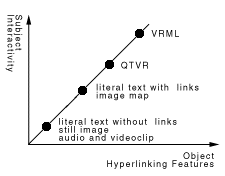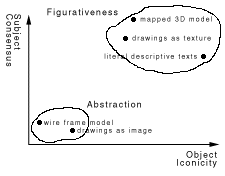
Fig. 1: Interacting with QTVR panorama of Piazza della Scala while browsing through historical documents
Our attention has been driven by the Teatro alla Scala, which is an important historical theatre for the Italian melodrama, based in Milano and very popular among citizen: designed by G. Piermarini (1731-1808) at the end of the XVIII century, after a fire that destroyed the older Regio Teatro Ducale, whose seasons started in 1589. In the application here described, we provide a variety of remote services: some related to performances on calendar and other current activities (exhibitions, lectures, announces, press releases etc.) and some to the theatre history and cultural heritage.
We face two objectives: to promote an active behaviour in the public and to increase its involvement. Therefore, we want to provide languages through which users can act upon objects to transform them. To this end, we selected among available technologies those resulting more seductive: in this prototype we used text, audio, video, voice, images besides QuickTime®VR (QTVR from now on) and VRML 2.0 (Virtual Reality Modelling Language).
In this paper we describe the application, LaScalaWeb, the web site of the theatre, and we analyse it, considering it as a composite object that can be read following different keys: functional, symbolic or historical etc.. We propose a structural analysis of narrative in terms of its syntactic-semantic relationship [Prince 93]. The understanding of a communicative artifact emerges following the inverse procedure adopted by its designer during construction: a composition of basic elements following given rules in order to produce the integral object providing meaningful effects. Users have to de-compose backward the object discovering its deep structure and finding out values underlying the object surface. We will apply this methodology to a specific section of the application: the virtual visit.
The events are presented to the general public on a day-to-day base, as the calendar evolves. The performances are documented by giving the program, the subject, the performing cast of the day, pictures taken from the stage documenting artists and the scenography, audio or video clips, pictures of costumes and their sketches. For operas the web site often offers the complete list of discography and bibliographic references.
The theatre manages a database that is used for internal administrative purposes. The web interfaces the information that are interesting to the public about performances held in the theatre since 1953. One can query about an author, an opera or a specific artist; one can also read about the orchestra composition and compare it with present days choices. To this respect the Teatro alla Scala is the first theatre to allow consultation of its archive via the network and the service has been welcomed by users, researchers and scholars but also opera fans. The virtual shop opened quite recently and it sells books edited by the theatre, together with programs of performances, photos and videos.
During these past three years, since it started to be operative, the web site has proved to be an important channel of communication between the theatre and its public. Mails, that in the beginning were mainly general compliments or to point out mistakes, are now used to ask more precise questions and show a high and focused level of interest. Often mails are sent by scholars searching for information about historical performances or news about artists.
The sense of history and evolution in time is given through a selection of original drawings and texts reporting some citizen impressions of the building at its first construction. Some alternative projects of the building are also documented, together with a reconstruction of the neighbourhood, which does not exist anymore after a square has been open in its place.
To show the theatre machina and to offer users clues of the complexity of the theatre life, we provide a series of still images of the theatre at work behind the scenery. Moreover, we draw the 3D model of the scenes of the opera Armide by C. Gluck (1714-1787), the opening opera of the past season, in order to allow their movements as during the performances. This animation can also be explored interactively by users, providing a new experience for the virtual spectators, different and more complete than the actual one. In fact spectators may not fully appreciate the complexity of the process of staging a performance and have little idea of the backstage. Virtual dancers can also be positioned on the stage and instructed to perform a baroque dance.
For virtual reconstruction present technology opens at least two possibilities: QuickTime®VR technology [Shenchang 95], that allows to return a powerful impression of the outlook of objects to be rendered, and VRML 2.0 [Ames et al. 97], that allows to implement interactive 3D environment returning spatial cues. The experience in using both technologies has shown advantages and limits, depending on the message that the designer chooses to communicate.
QTVR is perfectly suited to give a synthetic view of a complex environment. The public can navigate the space by selecting viewpoints, panning and zooming. Activating the context links another interior of the theatre is displayed. A different reconstruction of the space is achieved by VRML: placing different textures on the 3D model of the theatre we can return different levels of perception and information. In the VRML application we programmed animation, audio and light effects to convey better cues of the space.
Moreover, QTVR is less expensive than VRML, in that it takes less time to develop, and its transmission over the net is cheaper, because files are in average smaller. VRML requires more time also because it is based on a 3D model; the optimisation of the 3D model for effective Internet browsing is still critical. Both technologies can be make available for low cost computer platforms, but efficient VRML modelling is better done on high end graphics workstations.
A sequence of snap shots have been taken to reconstruct a possible visit of the theatre starting from the square, in which the theatre is located, namely Piazza della Scala. The 360deg. panorama are taken from strategic points in thetare, from the stalls and the balconies, from the foyer and from the stage, describing an architectural promenade. A specific node from the stage gives the unusual perspective of the scenery seen from the back looking at the stalls. Hotspots are implemented in the node to reference external documents, giving more details in text or photo formats about the theatre.

Fig. 1: Interacting with QTVR panorama of Piazza della Scala while browsing through historical documents

Fig. 2: The VRML model with texture maps
The VRML application can be visited by the public in two ways: by direct interactive navigation or by executing pre-programmed visits and animation.

Fig. 3: The interior VRML model
As for the first point of view, interactivity is a category describing users behaviour while hyperlinking features describe the nature of object. We state that active vs. passive behaviour in users is a function of the presence vs. absence of specific characteristics in the object. Active behaviour is promoted by the presence of hypertextual links, implemented in different ways according to interface and technical requirements as buttons, textual links, hot-spots and so on. In some cases, such as in QTVR or VRML applications, a high interactivity is granted even without explicit links: in QTVR samples users can interact, with 2 degrees of freedom, turning left/right and zooming, while in VRML users can navigate freely in the 3D space.


Fig. 4: analysing texts according to subject-object relationships
In our application, we mostly adopted highly figurative texts[1], allowing us to convey our interpretion of the essence of the theatre or its scaligerità. In Fig. 4 we plot on the subject consensus - object iconicity axes some partial texts, showing their degrees of figurativeness. We want to emphasise that, given a partial text, its degree of figurativeness can vary according to its occurrence. For instance, as it is shown in the figure, we used the original drawings by Piermarini in different contexts: as mere gif or jpeg images and as textures in VRML models. In the first occurrence, even though drawings are rather figurative, because they convey the idea of history and tradition through the pencil stroke and colour for instance, they are more abstract than in the second one, where they convey also spatial cues.
Moreover, for a given meaning there are several nuances, that we tried to convey by selecting appropriate technology. For instance, to express the scaligerità we distinguish between history and present time and according to the point of view we adopted different techniques. We used VRML to give the idea of the evolution of the building through the centuries, or even of the building that has been projected but never built, in synergy with highly figurative literal texts, rich of names, place and time references. Whereas, we preferred to use QTVR to describe the theatre present status. The intrinsic QTVR nature, based on image rendering technique, offers a satisfying perception of the environment, being based on photographs shots, but also limit the perception of the structural complexity of the real space. On the other hand VRML, even in the case when photos are textured on the surfaces, gives a somewhat cartoon effect.
Therefore, we can not conclude that QTVR is a more figurative language than VRML, in any occurrence, because it depends on the local context and the meaning that the designer wants to associate to the text. In this application, we made an effort to accurately evaluate case by case how to combine different parts of the virtual visit without inconsistencies.
Adopting a rough metaphor, the database can be seen as a collection of different boxes holding homogeneous data and a set of rules to combine them. The document has a temporary life: once it has been inspected, it implodes again into the database. To this respect we deal with digital way of life, that takes form at the time of its use. Following Hjelmslev [Hjelmslev 73], the database can be conceived as the system of all potential documents and each of them is the tangible result of one of the possible generation process. The designer control is weak on the document generation process, while it is strong on the retrieval system and on the interface design.
[Anceschi 93] Anceschi G. (1993). Il dominio dell'interazione, in Anceschi G. (ed) Il progetto delle interfacce. Oggetti colloquiali e protesi virtuali, Domus Academy, Milano (1993) [Hjelmslev 73] Hjelmslev, L. (1973) The basic Structure of Language. Essais linguistiques II, Travaux du Cercle Linguistique de Copenhague, vol. XVI, Nordisk Sprog- og Kulturvorlag, Copenhague
[LaScalaWeb 95] http://lascala.milano.it
[Marsciani & Zinna 91] Marsciani, F., & Zinna, A. (1991) Elementi di semiotica generativa. Processi e sistemi della significazione. Bologna, Italy: Esculapio Società Editrice
[Mitchell 96] Mitchell, W. J. (1996). City of bits. Space, Place and Infobahn. Cambridge, MA: M.I.T. Press
[Prince 93] Prince, G. (1993) On formalist narratology. Languages of design.1, 303-319.
[Shenchang 95] Shenchang, E. C. (1995). QuickTime®VR - An image based approach to virtual environment animation. Computer Graphics, proc. SIGGRAPH `95, ACM, 29-38
[1] In this context text indicates any object that can convey meaning, no matter which is the language used to produce it. Therefore a kind of text can be literal text, but also an image, a video clip or an applicative sample based on VRML or QTVR.
[a] Dipartimento di Scienze dell'Informazione, Università degli Studi di Milano, Via Comelico 39, 20135 Milano.
[b] Dottorato in Disegno Industriale, Politecnico di Milano, P.za Leonardo da Vinci 32, 20133 Milano.